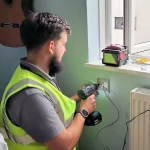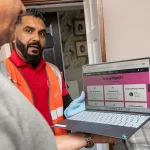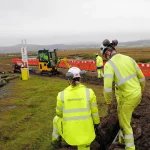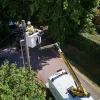BT Test Robots to Help Build and Fix UK FTTP Broadband Ducts

Telecoms giant BT has confirmed that they’re working with the UK university sector and other utilities to develop and trial a new range of robots, which they hope could be used by Openreach and others to help speed up the rollout of gigabit-capable Fibre-to-the-Premises (FTTP) broadband ISP networks and fix them when broken.
At present Openreach, despite having one of the largest fibre focused civil engineering teams in the country, aren’t always the fastest at adopting the latest cutting edge civil engineering solutions to help them rollout new infrastructure. For example, the recently adopted Clean Fast machine (here) and Air Wand (here), were both excellent additions, albeit ones that have been around for quite a few years already.
Admittedly, there have been some exceptions, such as the novel use of drones (here) to carry optical fibre cable over rivers and difficult terrain, as well as to help map and survey tricky areas. However, BT’s £15bn investment to help FTTP cover 25 million UK premises by December 2026 is now providing the drive to foster greater innovation.
Advertisement
As a result, the operator has just announced that they’re opening a new 5000+ sq. ft. robotics research facility in Suffolk (BT Labs), which is to focus on developing a new range of robotics to help the telecoms and related civil engineering sectors (i.e. Openreach won’t be the only beneficiary). The aim is both to speed up the rollout of fibre optic broadband and to find novel ways of repairing damaged infrastructure.
Some of the robots under development at the site will include those that can clear out blocked ducts, mend collapsed ducts and install new fibre network infrastructure without incurring the cost and delays that come with digging up roads and pavements – so-called “trenchless” infrastructure deployment. Some of this will adopt new robotic locomotion and excavation techniques, inspired by digging and burrowing mammals, and insects.

However, it’s not all focused on underground infrastructure, with BT also looking at telegraph poles and overhead fibre. “Magnetic, climbing and cable-traversing robotic techniques are also maturing, enabling proof-of-concept trials on wireless tower and overhead cable poles,” said the operator. The new facility will aid all this by emulating several different environments for the robots to be tested against.
Advertisement
Emulated Environments at BT’s New Robotics Facility
Underground environment:
The facility includes several test beds that can be filled with different soil and aggregate types to replicate the terrain that creates challenges for laying ducts and fibre across the country. The compaction, moisture content and stone content can all be controlled within these environments to test the ability of robots to dig pathways for ducts or direct-in-ground fibre. The test beds will also provide demanding environments for fibre sensing and robotics steering tests.In-duct environments:
Pipe stands are used at the facility to construct duct runs, using specially manufactured transparent versions of BT ducts. This enables replication of the scenarios whereby a duct collapses or becomes blocked with silt build up.Overhead environments:
The facility holds a full height telegraph pole, with platform access to allow different pole-top fixtures to be fitted. This creates opportunities to test robots that can lift tools, equipment or cable to the top of a pole. Cables can be run to another pole to provide a single 35m span for development of cable-car-like devices for pulling in new cables or dealing with tree canopies that could damage an existing cable. A series of shorter posts provides a ‘pole-transit’ testbed for developing other cable-travelling devices
The catch is that, right now, most of the robots being developed at this facility are still in the very early R&D or concept phase, although it’s clear from the press event that BT already has some prototypes of duct traversing and building robots on display.
Professor Tim Whitley, BT’s MD of Research, said:
“The UK is a hotbed of civil engineering innovation, with a thriving university ecosystem and an enviable robotics startup sector. Our aim is to bring those players together in a dedicated facility to develop solutions that make the UK a world leader in telecoms civil engineering robotics. The lab will provide a hub for the creation of solutions to real world challenges and pioneering applications of robots, reinforcing the UK’s position at the heart of research and innovation into advanced technologies.”
Naturally, it’s a bit too early to be asking when we might see such technologies being tested in the wild, but hopefully that will happen before the major build phase has finished in 2025/26. The other question will be whether or not they can actually cut costs vs more traditional approaches. No doubt, time and a lot more R&D will help to answer that one.
Mark is a professional technology writer, IT consultant and computer engineer from Dorset (England), he also founded ISPreview in 1999 and enjoys analysing the latest telecoms and broadband developments. Find me on X (Twitter), Mastodon, Facebook, BlueSky, Threads.net and Linkedin.
« Update on IPv6 Plans for Virgin Media, TalkTalk, Plusnet and Vodafone
Virgin Media O2 UK Update on Wholesale and FTTP Upgrade Plan »























































So basically a toilet paper tube with some wires attached to it?
Somewhat more complex then that. It needs to avoid other services and obstructiona
I assume the PVC pipe is attached to the end of the mole. What I caanot quite figure out is ho the wast soil is removed. THe only posible way seems to be to take it out through the PVC pipebut how you do that is the question
If the robot is able to pass through the damaged section to an access point then the attached line ould be used to drag other equipment into place.
The Little tubular bot with the Bristles only has 1 moving part, and is not designed to move or break through obstructions. It used the wires that trailed behind it as a power supply (batteries are planned for in the near future)
It didn’t move any obstructions, it’s designed as a camera, and if It met an obstruction, the field engineer could simply pull it out by its power cables and then fix the obstructions by other means.
I think BT see two main uses one is unblocking existing ducts but the main use seems to be for new build. If they can get it to work the savings are significant. In effect it will be a mini TBM